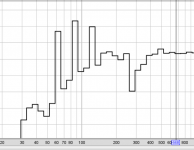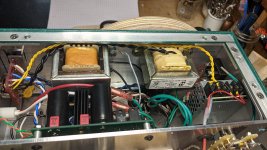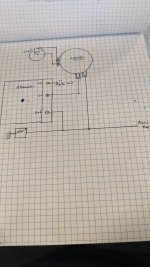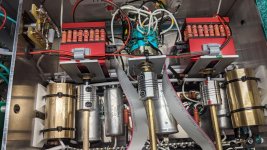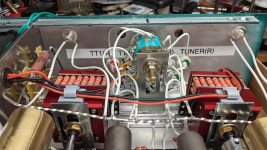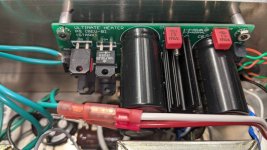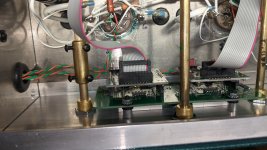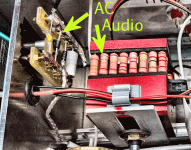I have two almost identical preamps that I built. Both hum similarly at above about half volume (using Khozmo ladder attenuators). Hum increases with increases in volume after the "half-way" point.
I'm looking for a way to measure this on the bench with either an oscilloscope or a multimeter set to AC.
Any instructions would be welcome.
I'm looking for a way to measure this on the bench with either an oscilloscope or a multimeter set to AC.
Any instructions would be welcome.
Does this include a phono preamp, or is it just a line stage? It could be either 60Hz or 120Hz hum,
and it may or may not look like a sine wave.
Connect the scope probe tip to the main output RCA hot terminal, and the ground clip to the
RCA ground shell. Set the vertical knob so the amplitude is several divisions high, and determine
the peak to peak voltage.
If it is 5 divisions high, and the knob is set to 10mV/div, that is 50mV peak to peak. Then factor in
the probe attenuation. If it is a x10 probe, multiply by 10, for a total of 500mV peak to peak.
To get the rms value, then multiply by 1/(2.818). Compare this with your DVM reading.
and it may or may not look like a sine wave.
Connect the scope probe tip to the main output RCA hot terminal, and the ground clip to the
RCA ground shell. Set the vertical knob so the amplitude is several divisions high, and determine
the peak to peak voltage.
If it is 5 divisions high, and the knob is set to 10mV/div, that is 50mV peak to peak. Then factor in
the probe attenuation. If it is a x10 probe, multiply by 10, for a total of 500mV peak to peak.
To get the rms value, then multiply by 1/(2.818). Compare this with your DVM reading.
Last edited:
It is independent of the phono-stage as it is the same with the inputs shorted.
This is done with REW software and a USB microphone.
This is done with REW software and a USB microphone.
Attachments
Last edited:
Sounds like a ground loop, can you post the schematic? Do you think it is 60Hz or 120Hz?
Could be 60Hz hum pickup from the power transformer.
Could be 60Hz hum pickup from the power transformer.
It is independent of the phono-stage as it is the same with the inputs shorted.
The 60Hz and 120Hz is electrically possible, but not the 90Hz. That must be acoustical.
The circuit designer wishes the schematic no be published so I'll PM you. I agree with the ground loop thing but all audio components are grounded to a bus with the bus grounded at one single point by the input jacks through a diode/resistor./capacitor network.
Can you also post here photos of the chassis layout?
A ground bus does not guarantee hum-free audio.
A ground bus does not guarantee hum-free audio.
Some inside pics.
Attachments
Yes. Really doesn't become troublesome until about half volume. This is with 101dB speakers and DIY Radiotron 2A3 amps. The amps are AC heated so they have a bit of their own hum but this is distinctly on top of that.
First check where the volume pot connects to the ground bus, compared to where
the tube cathodes and power supply returns connect. Where is that?
Both channels share the same ground bus? Is the power supply wired like the schematic
in terms of how the capacitor ground returns are connected to the rectifier?
Generally, the center of the shared ground bus should connect to the chassis and to the shared power supply.
The audio circuits connect to points farther away on each side of the center, and the input and volume control
returns connect to the far ends of the ground bus.
the tube cathodes and power supply returns connect. Where is that?
Both channels share the same ground bus? Is the power supply wired like the schematic
in terms of how the capacitor ground returns are connected to the rectifier?
Generally, the center of the shared ground bus should connect to the chassis and to the shared power supply.
The audio circuits connect to points farther away on each side of the center, and the input and volume control
returns connect to the far ends of the ground bus.
Last edited:
I have it wired very close to the schematic I sent you. The ground "network" is grounded to the chassis at the input jacks which are insulated from the chassis.
The PSU caps are at the other end of the bus. The cathode, resistor grounds as well as the attenuator grounds and the input and output grounds are daisy chained along the bus. I'll work on a sketch to post.
The PSU caps are at the other end of the bus. The cathode, resistor grounds as well as the attenuator grounds and the input and output grounds are daisy chained along the bus. I'll work on a sketch to post.
If the HUM is low @ min volume, and high @ mid volume and then low @ max volume you then have a loop pickup problem. The output Z of the attenuator is max @ mid volume position. What is the HUM LEVEL @ low, mid & max positions?
The 90Hz may be a power supply problem of mismatching of balance of the rectifiers or pcb routing. Do an FFT of the power supply voltages.
Duke
The 90Hz may be a power supply problem of mismatching of balance of the rectifiers or pcb routing. Do an FFT of the power supply voltages.
Duke
The hum is low at low volume medium at mid volume and high at high volume. The controls are Khozmo Ladder attenuators.
I'm afraid I have no idea how to do a FFT.
I'm afraid I have no idea how to do a FFT.
The Khozmo ladder networks are physically large, so plenty of room to pick up the power transformer's stray field. Demount them without removing the wiring, and move them around to check if there's a position where hum is "low enough". Otherwise, apply magnetic shielding.
Those are in the "hum breaker" network. Between the audio bus and the chassis. Clearly not working 🙂.
REW allows a much better frequency resolution of frequency spectrum than that the plot shown in post #3. In RTA, open the graph controls and in the pop-up box confirm that Mode is set for spectrum - also read the help files for a general understanding of the various controls. Of course that requires a low ambient noise environment when using a microphone. The 'Appearance' controls allow you to display a 'peak' plot that may allow easier indication of main frequency related continuous hum.
What meter options do you have, and have you tried to use that measurement for just the preamp output? If you can start with just the preamp by itself, with inputs shorted, then you may be able to categorise the hum when excluding certain sections (like, the hum breaker, and using a battery for heaters).
There is also a switchmode supply module in that mix?
What meter options do you have, and have you tried to use that measurement for just the preamp output? If you can start with just the preamp by itself, with inputs shorted, then you may be able to categorise the hum when excluding certain sections (like, the hum breaker, and using a battery for heaters).
There is also a switchmode supply module in that mix?
For diagnostic equipment I have two DVMs and an analog oscilloscope as well as a digital oscilloscope and a set of differential probes. I also have a BK signal generator.
Yes, there is a SMPS driving the attenuators. They require 5V DC.
Thanks for your help.
Yes, there is a SMPS driving the attenuators. They require 5V DC.
Thanks for your help.
Can a DVM register a non-zero measurement for hum output on the lowest ACV range (eg. a mVrms range) ? Always good to have a benchmark reading before making step changes.
Can the Digital scope do FFT ? If not then I recommend the soundcard and REW - although that can take some care to confirm there is no ground loop hum being inserted due to the measurement (ie. a laptop is a good PC for audio testing).
Can the Digital scope do FFT ? If not then I recommend the soundcard and REW - although that can take some care to confirm there is no ground loop hum being inserted due to the measurement (ie. a laptop is a good PC for audio testing).
- Home
- Design & Build
- Equipment & Tools
- How to Measure Hum?
